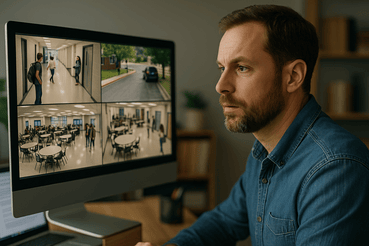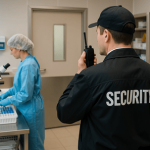
If you ask most school administrators why they have video surveillance, the answer usually comes quickly: “for security.” And while that’s absolutely true, there’s a new conversation happening in school districts across the country—how can we use our video surveillance systems for more than just reviewing past incidents?
Today’s school security systems offer far more than grainy footage of what happened yesterday. With high-resolution cameras, cloud storage, and smart analytics, K–12 campuses are discovering that video can support everything from facility management to community transparency.
Let’s talk about how your school can unlock the full value of its video surveillance investment—and why doing so helps build a safer, smarter, and more responsive campus.
l
l
Moving Beyond the Basics
Traditionally, video surveillance in schools was reactive. A fight broke out, something went missing, or there was a concern at the front door—and staff would pull up footage to see what happened.
Today’s systems—especially cloud-based, IP-connected ones—are much more dynamic. They offer:
-
Live monitoring and mobile access
-
Video analytics powered by AI
-
Integration with access control and emergency alert systems
-
Searchable archives and intelligent tagging
In other words, your school’s cameras are no longer just recording—they’re helping you manage, optimize, and protect your learning environment in real time.
l
l
5 Smart Ways Schools Are Using Video Surveillance Systems Today
1. Monitoring Building Usage and After-Hours Access
With facilities being used for sports, tutoring, community events, and extended learning programs, it’s hard to keep track of who’s where and when.
By reviewing video tied to your campus access control system, schools can:
-
Identify peak usage times for lighting and HVAC optimization
-
Detect unauthorized after-hours access
-
Monitor custodial coverage and contracted staff movement
This reduces wear and tear, saves money, and improves accountability.
l
l
2. Improving Drop-Off and Pick-Up Traffic Flow
Camera footage around school entrances and parking lots can help you identify patterns:
-
Are buses bunching up at certain times?
-
Are parents double-parking or blocking crosswalks?
-
Are students crossing unsafely?
Administrators and resource officers can use this data to adjust traffic patterns, improve signage, or reassign staff for better safety and flow.
l
l
3. Supporting Student Conduct Reviews and Restorative Practices
When there’s an incident in a hallway or common area, video footage gives clarity and context.
Principals and deans are using camera footage not only to determine what happened, but to support restorative conversations and prevent future conflict. It’s not about punishment—it’s about helping students take ownership and feel heard.
l
l
4. Training Staff on Real-Life Scenarios
Instead of hypothetical training sessions, many schools are using anonymized or archived footage to:
-
Teach proper hallway supervision
-
Demonstrate effective de-escalation
-
Review emergency response protocols
It’s a powerful tool for turning real events into learning moments for school staff and even school resource officers (SROs).
l
l
5. Sharing Transparency with Parents and the Community
While privacy must always come first, some schools are offering controlled, policy-based footage reviews for parents or stakeholders.
Examples include:
-
Confirming a reported injury on the playground
-
Addressing a bullying complaint with proper evidence
-
Supporting an IEP or behavioral meeting with context
This use of video surveillance can build trust when handled carefully and within FERPA and school policy guidelines.
l
l
Privacy Still Matters
Any discussion about expanding video use must include privacy protections, especially for minors. Here’s what SSP recommends:
-
Implement strict role-based permissions for accessing video
-
Use audit logs to track who views what footage
-
Ensure footage is encrypted and stored securely
-
Establish clear retention timelines aligned with policy
Responsible surveillance is about transparency and protection—not overreach.
l
l
Final Thoughts
Your school already has a powerful tool in place: its video surveillance system. But if it’s only being used after an incident, you may be missing out on its full potential.
By shifting your mindset from reactive to proactive, video footage can help improve safety, support students, train staff, and even save money.
At SSP, we help schools design, install, and manage video surveillance systems that do more than just record.
They inform. They protect. They empower.
Want to learn how to get more out of your existing video surveillance system?
Contact SSP today for a customized school safety assessment.


